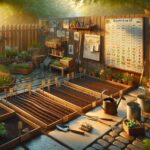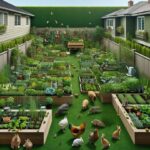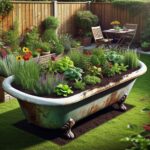
Unlock the Potential of Your Balcony with Non-Hybrid Seeds
Imagine stepping onto your balcony to a lush oasis of fresh vegetables and fragrant herbs, all grown by you. With non-hybrid seeds, this dream can become your reality. These seeds are the key to unlocking the potential of your urban space, no matter how small, and turning it into a productive garden that can provide you with a bounty of produce season after season.
Article-at-a-Glance: Essentials for Balcony Garden Success
- Non-hybrid seeds are sustainable and can be saved for future planting.
- Understanding the difference between non-hybrid, hybrid, and heirloom seeds is crucial.
- Selecting the right seeds for your balcony’s sun exposure and space is essential.
- Proper planting and care will ensure your balcony garden thrives.
- Harvesting and seed saving techniques will prepare you for next year’s planting.
Nurturing Your Green Space: The Basics of Non-Hybrid Gardening
Non-hybrid seeds, also known as open-pollinated seeds, are your ticket to a garden that keeps on giving. Unlike hybrid seeds, which are engineered for one-time use, non-hybrid seeds can be saved and replanted year after year, preserving the genetic diversity of your plants. This not only saves you money but also contributes to a more sustainable gardening practice.
Starting your balcony garden with non-hybrid seeds means you’re in control. You’ll know exactly what you’re growing, and you can select varieties that are well-suited to your urban environment. Plus, you’ll get to experience the joy of seeing your plants evolve and adapt to your specific conditions over time.
Choosing the Best Non-Hybrid Seeds for Your Balcony
When it comes to balcony gardening, space is at a premium. You want to make sure that every seed counts. That’s why choosing the right non-hybrid seeds is so important. They need to be well-suited to container growing, have a size that’s manageable for your space, and thrive in the amount of sunlight your balcony receives.
It’s also important to source your seeds from reputable suppliers. This ensures that you’re getting genuine non-hybrid seeds that will produce the results you’re looking for. A trusted supplier like Survival-Essentials.com offers a wide selection of heirloom seeds that are perfect for balcony gardeners looking to secure their family’s future with nutritious, home-grown food.
Understanding Seed Varieties: Heirloom vs. Open-Pollinated
Before you get your hands dirty, let’s clear up some common confusion. All heirloom seeds are non-hybrid, but not all non-hybrid seeds are heirlooms. Heirloom seeds are a subset of non-hybrid seeds that have been passed down through generations, often with a story and unique characteristics. Open-pollinated seeds, on the other hand, include any non-hybrid seed that can naturally reproduce itself.
Both types of seeds are excellent choices for balcony gardens, as they offer stability in plant traits from one year to the next. This means you can develop a deeper understanding of how your plants grow and what they need to flourish, creating a stronger and more resilient garden over time.
Top Non-Hybrid Vegetables and Herbs for Balcony Thrivers
When you’re picking plants for your balcony garden, think about what you love to eat. There’s nothing better than harvesting your own veggies and herbs. For a bountiful garden, some top non-hybrid vegetables and herbs include cherry tomatoes, which love pots and climb happily; leafy greens like spinach and kale, which grow quickly; and herbs such as basil, chives, and parsley, which are easy to maintain and perfect for snipping fresh into dishes.
- Cherry Tomatoes – Compact, climber, loves sun.
- Spinach – Quick grower, great for salads.
- Kale – Hardy, nutrient-rich.
- Basil – Aromatic, perfect for pesto.
- Chives – Hardy, adds oniony flavor.
- Parsley – Versatile, grows well in partial shade.
- Peppers – Thrive in warm, sunny balconies.
- Radishes – Fast-growing, great for beginners.
Remember, these plants don’t need a lot of room to thrive, making them ideal for your high-rise haven.
Designing Your Balcony Garden Layout
Designing your garden layout is like creating a mini ecosystem. Start by observing your balcony at different times of the day to understand where the sun hits and where shadows fall. Then, sketch a simple plan to visualize where each plant will go. Think about which plants need the most sun and which can handle a bit of shade. Grouping plants with similar water and light needs together makes your gardening easier.
Also, consider the height and spread of each plant at maturity. This will help you avoid overcrowding and ensure each plant has enough space to flourish.
Maximizing Space with Vertical and Container Planting
Vertical gardening is a game-changer for small spaces. Use trellises, hanging baskets, and wall planters to grow upwards. This not only saves valuable floor space but also adds a lush, green vibe to your outdoor area. Containers are another balcony gardener’s best friend. Choose pots of different sizes to accommodate different root depths, and always ensure they have good drainage.
- Use stackable planters for herbs and strawberries.
- Install a trellis for climbing plants like peas and beans.
- Hang baskets for trailing plants like nasturtiums and petunias.
- Repurpose shoe organizers for a vertical herb garden.
- Select railing planters to make use of perimeter space.
With a little creativity, you can double or even triple your planting area!
Microclimate Considerations for Seed Selection and Placement
Your balcony is unique, with its own set of microclimate conditions. Some areas might be windier, which could dry out plants quickly, while others might be more protected and retain moisture. Some spots might get full sun, while others are shaded. Select and place your seeds based on these microclimates to give them the best chance of thriving.
- Place drought-tolerant plants in windy areas.
- Keep moisture-loving plants in more protected spots.
- Use reflective surfaces to increase light for sun-loving plants.
- Consider shade-tolerant plants for areas with less direct sunlight.
Observing and understanding your balcony’s unique conditions will guide you to garden success.
Planting and Caring for Your Non-Hybrid Seeds
Planting your non-hybrid seeds is where the fun really begins. Fill your containers with a good quality potting mix, which will provide the right structure and nutrients for your plants. When sowing your seeds, follow the instructions on the packet for depth and spacing. Some seeds can be sprinkled right on top of the soil, while others need to be buried a little deeper.
After planting, water gently but thoroughly. The goal is to keep the soil moist but not waterlogged. As your seeds germinate and grow, thin out any overcrowded areas to give each plant enough room to mature.
Remember, your plants will depend on you for their nutrients. A balanced, water-soluble fertilizer can be added to your watering routine every few weeks to keep your plants happy and healthy.
Sowing Techniques for Container Gardens
When you’re working with containers, you’ve got to get sowing just right. Each seed has its own personality and preferences. Some like to be nestled into the soil, while others prefer to sit right on top where they can get all the light they need. Always check the seed packet for specific instructions, but here’s a general guide:
- Small seeds can be sprinkled on the soil surface and gently pressed in.
- Larger seeds need to be buried about two times their diameter.
- Space your seeds out to give each plant room to breathe and grow.
- Label your containers with the plant name and sowing date to keep track.
- Use a spray bottle to moisten the soil without disturbing the seeds.
- Cover pots with plastic wrap to create a greenhouse effect until seeds sprout.
- Once seedlings appear, remove the cover and provide plenty of light.
Remember, the right start makes all the difference. So take your time with sowing, and you’ll see the rewards in sprouts.
Watering, Feeding, and Sunlight Tips for Balcony Gardens
Your balcony garden is like a little ecosystem that relies on you. Watering is more art than science, and it’s all about balance. Stick your finger into the soil; if it’s dry a couple of inches down, it’s time to water. Early morning is the best time to water, giving plants a chance to drink up before the heat of the day.
Feeding your plants is just as important. A balanced, organic fertilizer every few weeks will do wonders. And sunlight? Well, that’s the magic ingredient. Most veggies need about six hours of direct sunlight a day. If your balcony gets less, consider leafy greens and herbs which can handle some shade.
- Check soil moisture regularly — containers dry out faster than the ground.
- Water deeply but less frequently to encourage strong root growth.
- Choose organic fertilizers that release nutrients slowly.
- Rotate your pots occasionally to ensure even sunlight exposure.
Keep a close eye on your plants, and they’ll let you know what they need. A little droopy? Time for water. Pale leaves? They might need a nutrient boost.
Sustaining Your Garden: Harvesting and Seed Saving
As your balcony garden matures, the excitement builds. Harvesting your own produce is incredibly rewarding, and with non-hybrid seeds, you can sustain your garden year after year. Learning when to harvest and how to save seeds is the final piece of the urban gardening puzzle.
The Harvesting Window: Recognizing the Right Time
Timing is everything when it comes to harvesting. Pick too early, and you might miss out on flavor. Too late, and you could end up with tough veggies. Most plants will give you signs that they’re ready — tomatoes turn bright red, peppers feel firm, and leafy greens look lush and full.
Here’s a simple tip: regular harvesting encourages more production. So don’t be shy about snipping those herbs or picking those beans. The more you harvest, the more your plants will give back.
Seed Saving 101: Preparing for Next Year’s Garden
Seed saving is like bottling up a bit of this year’s garden to sprinkle out next year. It’s a simple process, but there are a few things to keep in mind. First, let your best plants go to seed. Choose the healthiest, most vigorous plants as your seed sources. Then, once the seeds are mature and dry, collect them on a sunny day when there’s no dew.
- Label envelopes with the plant name and date before storing seeds.
- Keep seeds dry and cool — a jar with a desiccant packet works great.
- Don’t mix seeds from different plants to avoid confusion next season.
- Share your seeds with friends and neighbors to spread the gardening love.
With these tips, you’ll be well on your way to a self-sustaining balcony garden that brings joy and fresh food to your urban life year after year.
Frequently Asked Questions
Why are non-hybrid seeds beneficial for balcony gardening?
Non-hybrid seeds are a boon for balcony gardeners for several reasons. They are cost-effective because you can save seeds from your plants at the end of the season for future planting, reducing the need to buy new seeds every year. These seeds are also more resilient and adaptable to your specific balcony conditions, as they haven’t been bred for uniformity but for survival and reproduction in varied environments. Plus, they often have a richer flavor and more nutritional value than their hybrid counterparts, making your homegrown produce not just more sustainable but tastier and healthier too.
How do non-hybrid seeds contribute to biodiversity?
Biodiversity is the spice of life in the plant world, and non-hybrid seeds are its champions. Each plant grown from non-hybrid seeds can develop unique traits that help it adapt to its environment. This diversity strengthens the ecosystem, making it more resilient to pests, diseases, and changing climate conditions. By growing non-hybrid seeds on your balcony, you’re participating in the preservation of genetic variety, which is crucial for the health of our planet and future food security.
What are the best practices for germinating non-hybrid seeds?
Germinating non-hybrid seeds is like nurturing a tiny life — it requires care, patience, and a bit of know-how. Start with quality soil that’s loose and rich in organic matter. Make sure your pots have good drainage to prevent waterlogging. Plant seeds at the right depth — a general rule is to plant seeds two to three times as deep as their diameter. Keep the soil moist but not soggy, and provide a warm environment for seeds to sprout. Some seeds may benefit from a period of stratification or soaking before planting. Always check the seed packet for any specific germination tips.
Can I grow fruiting plants from non-hybrid seeds in a balcony garden?
Absolutely! Fruiting plants like tomatoes, peppers, and even small varieties of cucumbers can thrive in a balcony garden when grown from non-hybrid seeds. The key is to choose varieties that are suited to container life and to provide them with the right conditions — enough sunlight, consistent watering, and proper support as they grow. Dwarf or bush varieties are especially well-suited for balcony gardens, as they require less space to spread out. With the right care, you can enjoy a bountiful harvest from your balcony garden.
How do I store non-hybrid seeds for long-term use?
Storing non-hybrid seeds properly means you can secure your garden’s future for seasons to come. The key is to keep them in a cool, dry place away from direct sunlight. Moisture and heat are the enemies of seed longevity, so consider using an airtight container like a glass jar with a tight-fitting lid. To absorb any excess moisture, add a desiccant packet or a spoonful of dry rice or powdered milk wrapped in a piece of cloth.
- Label each container with the seed type and the date of storage.
- Store seeds in a cool, dark place, such as a basement or a refrigerator.
- Avoid fluctuations in temperature which can damage the seeds.
- Check on your seeds occasionally to ensure they remain dry.
- Consider freezing seeds for very long-term storage, but only if they are completely dry to avoid damage from ice crystals.
By following these steps, your seeds can remain viable for several years, ensuring you have a robust selection to choose from for future planting.
In conclusion, balcony gardening with non-hybrid seeds is a rewarding and sustainable way to bring a slice of nature into your urban life. From selecting the right seeds to harvesting your crops and saving seeds for the next season, each step brings its own joy and learning experiences. As you nurture your plants, you’ll also nurture a deeper connection to the food you eat and the environment you live in.
Remember, every balcony garden is unique, and what works for one may not work for another. Experiment, observe, and adapt. Share your experiences with others and learn from the community. Your balcony garden, no matter how small, is a powerful step towards a greener, more sustainable world.
So grab some non-hybrid seeds and get started. Your urban oasis awaits!
Frequently Asked Questions
Can I use non-hybrid seeds if I’m new to gardening?
Yes, non-hybrid seeds are perfect for beginners! They often come with detailed growing instructions and because they are open-pollinated, they can be more forgiving and adaptable to different conditions. Plus, as you learn, you’ll be able to save seeds from the healthiest plants, giving you a personalized seed stock that’s well-suited to your specific gardening style and environment.
Do non-hybrid seeds require special soil or fertilizers?
Non-hybrid seeds don’t require special soil or fertilizers, but they do thrive in nutrient-rich, well-draining soil. Organic fertilizers are a great choice for providing the nutrients your plants need in a natural, sustainable way. Regular compost or compost tea can also be very beneficial for your balcony garden.
Are there any legal considerations with saving and sharing non-hybrid seeds?
In most cases, saving and sharing non-hybrid seeds is perfectly legal and encouraged among the gardening community. However, it’s always a good idea to check your local regulations, especially if you plan to sell seeds, as there may be specific laws or requirements in your area.
What should I do if my balcony doesn’t get a lot of sunlight?
If your balcony is shaded, focus on growing plants that don’t require as much sunlight, such as leafy greens, herbs, and some root vegetables. You can also use reflective materials to increase light exposure, or consider grow lights if you want to expand your plant options.






